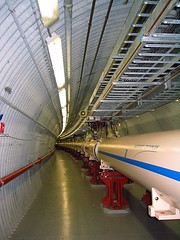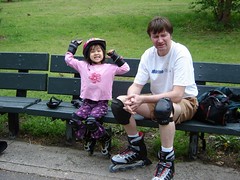Friday, December 08, 2006
The Ghost Map, by Steven Johnson
Apart from the gripping story of the cholera epidemic, there are a couple of themes that I thought Johnson discussed particularly well. The first I mentioned above - Johnson explores how scientific ideas are shaped by ideological context. It's not a revolutionary idea, but the book has a particularly graphic and rich example in terms how diseases and the possibility of microbes were conceived of in mid-19th century Europe.
The second fascinating theme Johnson touches on in the end, with a discussion of how London, with is population of 2 million in the 1850's, was an experiment in whether that many people could actually live packed so densely together. It was a time when rudimentary water and sewer services were just being planned and built, and Johnson is particularly graphic is describing how the garbage and sewage of the city's inhabitants were handled. The experiment succeeded of course and we have megacities now, some of whose slum areas are repeating the developments that London went through 150 years ago. In any case, it's an interesting study of the history of cities on our planet.
I highly recommend this quick but informative read - you'll not only ponder the nature of scientific inquiry and the development of cities, but also learn what pure-finders search for and how cholera strips the epitheleal cells from the small intestine thus leading to a "rice water" stools. Priceless!
Wednesday, August 23, 2006
Low tech to high: camping and a visit to a particle accelerator

Last weekend we went camping near the town of Greenport on the North Fork of Long Island. The beaches on the North Shore are rocky, which makes the swimming experience not so enjoyable, but they were still beautiful, and especially tranquil in the late afternoon sun. We really enjoyed ourselves in the town of Greenport, quiet and charming, where people treated us in a normal, friendly manner rather than as tourists to be barely tolerated. (Greenport photos here)
Camping is easier than it used to be - our tent popped right up and we managed to set up in the evening dark without any drama. The only drama was our second night there when it bucketed down with rain! I spent much of the night waking up intermittently and wondering when the tent was going to start leaking; fortunately we only got a few sprinkles during the final downpour at about 6 am (maybe the tent had finally had enough of repelling water?). The private campground, Eastern Long Island Kampground, was full of RVs but, thank god, a lot quieter than the state park we stayed at last year (Wildwood on the North Shore).
So last year after our camping trip we decided to drop by Brookhaven National Laboratory because I had read they had tours there on certain summer Sundays. Wow, we had such a great time seeing their biology labs (DNA analysis, electron microscopes and much more) that I thought we ought to come back this year. In fact, this year we timed the camping to coincide with a visit to Brookhaven's RHIC (Relativistic Heavy Ion Collider), a particle accelerator that is currently the most powerful heavy-ion collider in the world. What does that mean, you say? Well, I don't REALLY understand the physics of it all, but if I understand correctly basically you have two tubes in which sub-atomic particles run clockwise and counter-clockwise in a big 2+ mile circle at 99.995% the speed of light. At 6 points the two tubes cross over each other and that's where the streams can intersect and the particles running in opposite directions can collide - BOOM! (Interestingly enough, there was speculation at one point that the RHIC could create a black hole or another phenomenon that would destroy the earth - Wikipedia explains). Anyway, there are detectors built at the intersection points and they record the results of the collision, teaching us a lot about -- well, about what conditions may have been like right after the Big Bang and about lots of other stuff I don't even pretend to grasp.
Even though I don't understand it, I can still be impressed with the science of it, the engineering of it (individually built circuit boards, hand coding of software, etc.) and the sheer enthusiasm of the hundreds of scientists running experments on it. In fact, what makes these visits to Brookhaven so exciting is that the tour guides are the actual scientists working on the experiments. These are not museum exhibits where you are lectured about science, this is living, breathing scientific work being conducted by brilliant and occasionally very eccentric scientists. Here I should stop and mention Dr. Achim Franz of the PHENIX experiment, who gave us a great feel for the life of a physicist - years spent designing the experiment and the detector, the work of maintaining the detector, the terabytes upon terabytes of data, the scientists all over the world who analyze the data and use the results, the time spent in committee meetings coming up with acronyms like PHENIX, and all the rest - thank you Dr. Franz!
Anyway, it was an excellent geek adventure and for anyone who's interested in science (or especially anyone who has kid(s) interested in science), I can't recommend it enough. I'm looking foward to returning next year -- maybe we'll go see the National Weather Service, and try to camp in Montauk! (more RHIC photos here )
Monday, June 19, 2006
My first youtube posting
Anyway, the music was great - I've liked rai since I first heard it in Tunisia almost 20 years ago, and this was something related, which the program calls yal... Takfarinas' style is "a blend of Kabylian folk, French pop, flamenco, reggae and funk."
Summerstage was filled with young people dancing, drinking, and checking the scene out. I felt old. But we had a great time dancing, sweating (it was torrid), and in Maia's case, jumping, leaping, sprinting, and I don't know what else!
Thursday, June 08, 2006
Rollerblading Newbies

DSC00142
Originally uploaded by Ruru.
After all those hours at Modell's trying out rollerblades, it was finally time to put them on and give them a try! We didn't do too badly.
Staying true to form, Paul went out and skated as fast as he could around and around, and I went back and forth in front of the benches until I could sort of skate, slowly but without falling. Maia needs a little more practice but she was willing to give it a shot!
Delia, who tried out her new spiffy blades, took these photos plus many videos, which I'll try and post on YouTube.